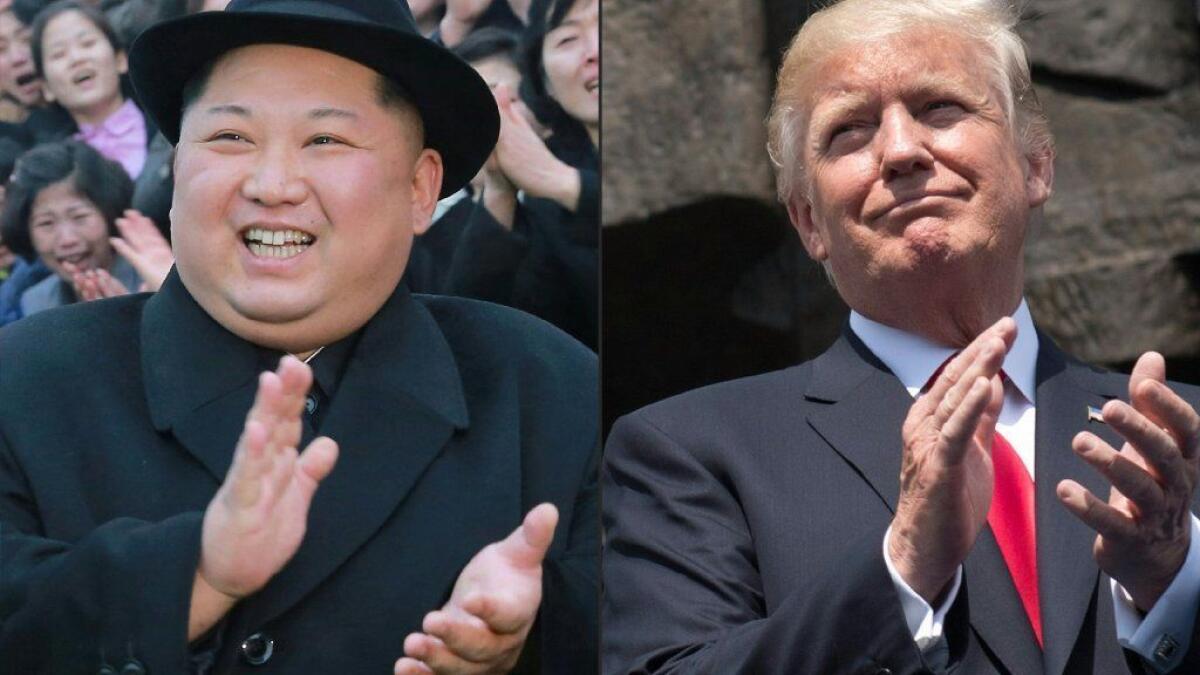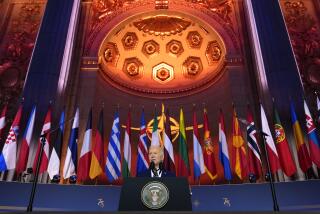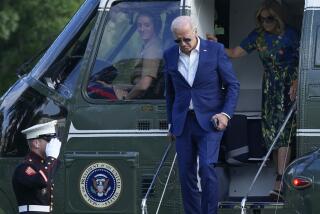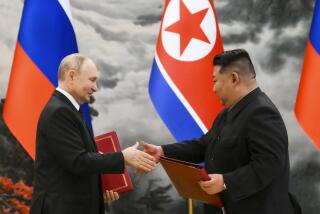Trump’s summit with Kim poses risks and benefits for two volatile leaders

Reporting from Washington — In one corner, Little Rocket Man. In the other, the Deranged Dotard.
After months of crude insults and bellicose threats, President Trump’s quick acceptance of North Korean leader Kim Jong Un’s surprise invitation to meet in May has lowered nuclear tensions — at least for now — on the Korean peninsula.
But the summit carries risks that will test Trump’s unconventional political style and vaunted negotiating skills while putting Kim on the global stage at a level with the U.S. president, a North Korean goal for decades.
While the White House took pains to insist that Trump made no concessions to get Kim to the table, squaring off face-to-face with Trump already marks a dramatic success for the ruthless and reclusive dictator.
Whether Trump will gain anything in return remains to be seen. He has decried the lengthy negotiations of the past that ultimately collapsed when, in the U.S. view, North Korea broke its promises.
Given the personal nature of their insults, both men undoubtedly will use the summit to get the measure of each other, and try to decide who is better at bluffing. U.S. presidents have had mixed luck at that kind of high-stakes poker in recent decades, but Trump has made clear he views most of his predecessors as incompetent
Few diplomats believe Kim will seriously consider relinquishing North Korea’s nuclear weapons or the infrastructure to build them. And unlike in the earlier negotiations, Kim comes to the summit from a position of strength.
He has all but developed a credible nuclear deterrent — a proven nuclear weapons capability, an arsenal of several dozen warheads, and intercontinental ballistic missiles that ultimately can deliver them.
It’s significant that Kim agreed to freeze further tests while talks are underway. But he didn’t offer to eliminate his weapons, or let international nuclear inspectors return to North Korea.
The Trump administration said the president has also scored a victory because he’s convinced that he can personally persuade Kim to move toward denuclearization where all others have failed.
“This is something [Trump has] had on his mind for quite some time,” Secretary of State Rex Tillerson said in Africa, where he is traveling this week.
The White House spokeswoman, Sarah Huckabee Sanders, offered a tougher line Friday than she had a day earlier. She rejected criticism that Trump had given a free pass to Kim, and suggested the summit might not actually happen.
“The maximum-pressure campaign, we’re not letting up. We’re not going to step back or make any changes to that,” Sanders told reporters. “We’re going to continue in that effort. And we’re not going to have this meeting take place until we see concrete actions that match the words and the rhetoric of North Korea.”
She added, “We’ve accepted the invitation to talk based on them following through with concrete actions on the promises that they’ve made.”
Those include, she said, a promise to “denuclearize,” to stop nuclear and missile tests, and to accept U.S.-South Korean military exercises.
U.S. officials concede they were caught off guard by the invitation, which Kim offered during a 4½-hour meeting with visiting South Korean officials in Pyongyang early this week.
The South Koreans said Kim was candid about how badly U.S. and international sanctions were hurting North Korea’s economy, leading to shortages of basic commodities and causing trade to plummet, according to people familiar with the conversation.
Still, the president’s decision to accept the invitation was quintessential Trump: dramatic, stunning and announced so quickly that the two governments haven’t even selected a day or place to meet.
Nor have U.S. diplomats and experts begun to prepare for a high-stakes presidential summit. Even those that don’t involve nuclear weapons normally require massive inter-agency preparations and consultations with Congress and allies.
Critics were quick to raise warning flags that the meeting could backfire if Trump, never known for his grasp of details, is unprepared.
“I think it is really dangerous,” said John Park, a North Korea specialist at Harvard’s Kennedy School of Government.
“It is one thing thinking you have a minefield map, and another to sprint through,” he added. If the meeting goes badly, both leaders could give up on diplomacy and “focus on more of the military options.”
Traditionally, a meeting with a U.S. president is a reward given to a negotiating partner who has made concessions, and the president goes in at the end as the “closer.”
Trump has blown up most traditions since entering the White House, so perhaps it’s not surprising he would upend another. Still, in this case, he has acquiesced to see Kim with no concrete quid pro quo.
Even some of Trump’s allies were nervous about sending the wrong message.
North Korea “must also know that while the United States and its partners are seeking to solve this crisis peacefully, we will not hesitate to defend the U.S. homeland, our troops in the region, and our treaty allies, with overwhelming military force,” said Sen. Cory Gardner of Colorado, a Republican member of the Foreign Relations Committee.
“The military option must remain on the table, it must be robust, and [North Korea] must be made fully aware of the consequences of their actions.”
U.S. officials say they are painfully aware that Kim may try to get the better of Trump by secretly using drawn-out talks to buy time to upgrade his nuclear program, as North Korea has in the past, or blowing up negotiations with another missile launch or other provocative behavior.
“Past denuclearization efforts have foundered on a combination of failures to secure verification and North Korean subterfuge, but have never gone so far in giving the Kim family the prestige or treating North Korea with the strategic weight that it has sought for decades,” said Scott Snyder, a Korea expert at the nonpartisan Council on Foreign Relations.
Just picking where to meet is fraught with potential conflicts. Although he attended school in Switzerland, Kim has not left North Korea since he rose to power in 2011. He may only be willing to go as far as the so-called truce village Panmunjom along the heavily fortified border between North and South Korea.
Other options include Jeju Island, in the Korea Strait, which Seoul has called “Peace Island”; a city in a neutral country such as Mongolia; or one of the Chinese industrial cities along North Korea’s northern border.
Beijing also has been floated as a possible summit site, given how Trump repeatedly has praised China’s help pressuring Kim. But Kim has resented that pressure and may not want to elevate China’s importance in the relationship.
Trump spoke by phone Friday with Chinese President Xi Jinping. In a statement, the White House said the two leaders “welcomed the prospect of dialogue between the United States and North Korea, and committed to maintain pressure and sanctions until North Korea takes tangible steps toward complete, verifiable, and irreversible denuclearization.”
Trump spoke late Thursday with Japanese Prime Minister Shinzo Abe, a close partner in efforts to constrain North Korean aggression, the White House said.
For more on international affairs, follow @TracyKWilkinson on Twitter
UPDATES:
12:55 p.m. This story was updated with new details from the White House.
This story originally posted at 12:10 p.m.
More to Read
Sign up for Essential California
The most important California stories and recommendations in your inbox every morning.
You may occasionally receive promotional content from the Los Angeles Times.












